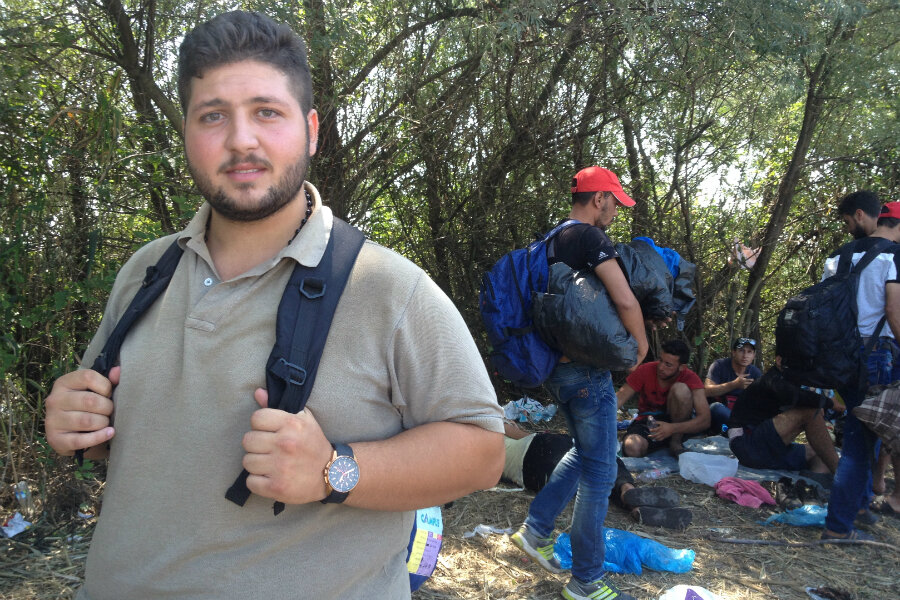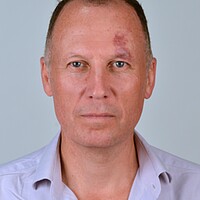Young Syrian migrant's navigational tool: 'I follow the trash'
Loading...
| Roszke, Hungary
When 23-year-old Abood set out alone from war-torn Syria a month ago in the hope of reaching sanctuary in northern Europe, the prospect of navigating through countries he knew nothing about was daunting.
The reality, it turned out, was rather easier, if fraught with danger.
“I follow the trash,” he told the Monitor, pausing by the side of a railway track just yards from the border between Serbia and Hungary, a frontline European Union country in the Continent’s deepening migration crisis.
“I feel a bit ashamed that Syrians have left so much garbage along the way," he says, "but it makes it very easy to find the right way to go.”
Ahead of him, the railway track curved between orchards, vineyards, and fields of sunflowers.
It was lined with discarded babies’ diapers, empty potato chip packets, plastic water bottles, items of grubby clothing, and abandoned identity cards written in Arabic.
Amid much fanfare and domestic political posturing, Hungary has in the past few weeks erected a razor-wire barrier along its 110-mile border with its southern neighbor, Serbia.
But the barrier stops either side of the train track, close to the Hungarian border village of Roszke, and thousands of refugees were able to simply walk across the frontier, despite the presence of a handful of Hungarian police.
Echoes of World War II – with high-tech additions
The sight of thousands of refugees tramping along rusty railway lines carrying their meager possessions in plastic bags and cheap backpacks, evokes images of World War II in Europe, when millions criss-crossed the Continent fleeing the barbarities of Nazism and Communism.
But 70 years on, today’s refugees are using distinctly 21st century means of finding their way – relying heavily on smart phones, digital maps, and social media forums.
The Syrians, in particular, are tech-savvy, and almost without exception carry smart phones that enable them to glean advice from other migrants about which routes to follow, which checkpoints to avoid, and where to seek shelter.
Facebook, Whatsapp, and other social media sites are key tools in the long march from countries like Syria, Iraq, and Afghanistan toward the European Union.
Aside from following trails of trash at key border points, Abood also depends on his phone.
To ensure constant access to information, the young man, who declined to give his surname for fear of endangering the lives of relatives still stuck in Syria, carries a state-of-the-art mobile phone charger in his fanny pack. He has had it ever since leaving his home town of Latakia, Syria’s main port on the Mediterranean.
Once it is charged, it contains enough electricity to keep his mobile phone powered up for days.
He buys local SIM cards in each new country he reaches.
“People use text messages to give each other advice – ‘do that, don’t do that, that place is expensive, that place is cheap.’ Everybody helps each other,” he says.
Abood's route
After crossing from Syria to Turkey, he paid smugglers $1,000 to take him in a rubber dinghy from the Turkish coast a few miles across the sea to Lesbos, one of the nearby Greek islands of the Aegean.
He took a ferry to Athens, made his way by train to the Greek border with Macedonia, crossed that country, traversed the length of Serbia and arrived at the border with Hungary.
His ultimate objective is Belgium, where he hopes to be able to continue his studies in motor engineering design.
“I’m crazy for cylinders and engines,” he says enthusiastically, as a dozen fellow Syrians lie in the shade of a plum tree, exhausted after their long trek across the border.
“I want a job. I don’t want help from anyone; I just want a safe life," he says. "I’m not happy to be here, but what can we do? People in Syria have no hope now. They just watch the sky, waiting for the bombs to drop. There’s no water, no electricity. If the war stopped today, I would go home.”
The refugees encountered by the Monitor reckoned that their journey from Syria to Europe would cost them each between $3,000 to $5000.
Aside from the dinghy crossing from Turkey to the Greek islands, they want as little involvement as possible with traffickers, and so travel independently.
Resting in an orchard about 100 yards from the border, Mohamad Alhriri, a 35-year-old lawyer, was one of a group of Syrian men who planned to cross the frontier at night and then find a taxi to take them to Budapest, and from there to Vienna and then to Munich.
They reckoned on paying 250 euros ($282) each for the two-hour journey.
It is expensive, but they are afraid that if they take a bus or train they will be stopped by the Hungarian police and sent to a migrant center, where they could languish for weeks.
The risk of robbery means that it is too dangerous to carry large amounts of cash.
The Syrians – many of them middle-class professionals – instead rely on relatives back home to wire them money through cash transfer agencies such as Western Union.
They collect the funds in each large city they travel through.
As for their plans, many said they wanted to settle in Germany, which expects to receive up to 800,000 asylum seekers this year – the largest number in its post-war history.
Others cited Britain, the Netherlands, and the countries of Scandinavia as their destinations of choice.
“I don’t want to stay in Hungary,” said Mohamed, a 27-year-old student of English from Damascus who had walked four miles along the railway line from a town on the Serbian side of the border.
“My biggest wish is to travel to England because I hear that the people there are very kind and very good. But I know that is extremely hard so my next choice is Germany.”
More than 3,000 refugees and migrants, many of them Syrians, Afghans, and Iraqis fleeing conflict at home, are pouring across the border into Hungary each day, and the country is struggling to cope.
Some hobbled on crutches, suffering from gunshot wounds that they said were inflicted by Syrian regime soldiers, while many carried babies in their arms and exhausted toddlers on their shoulders.
Officials say they expect even these unprecedented numbers to swell in coming days.
The government in Budapest said on Thursday that the number of refugees trying to reach Western Europe through Hungary could reach 300,000 by the end of the year.
Stephen Ryan, a spokesman for the International Federation of Red Cross and Red Crescent Societies, says: “Until there are better avenues for legal migration, we will continue to see scenes like this. This is the only option that people have open to them.”









